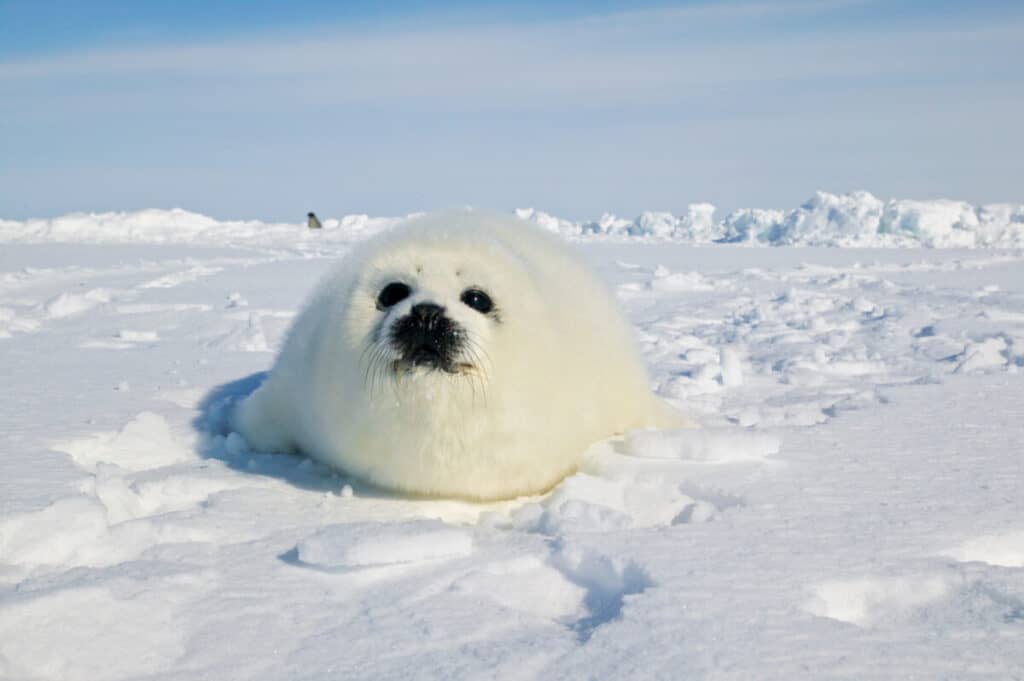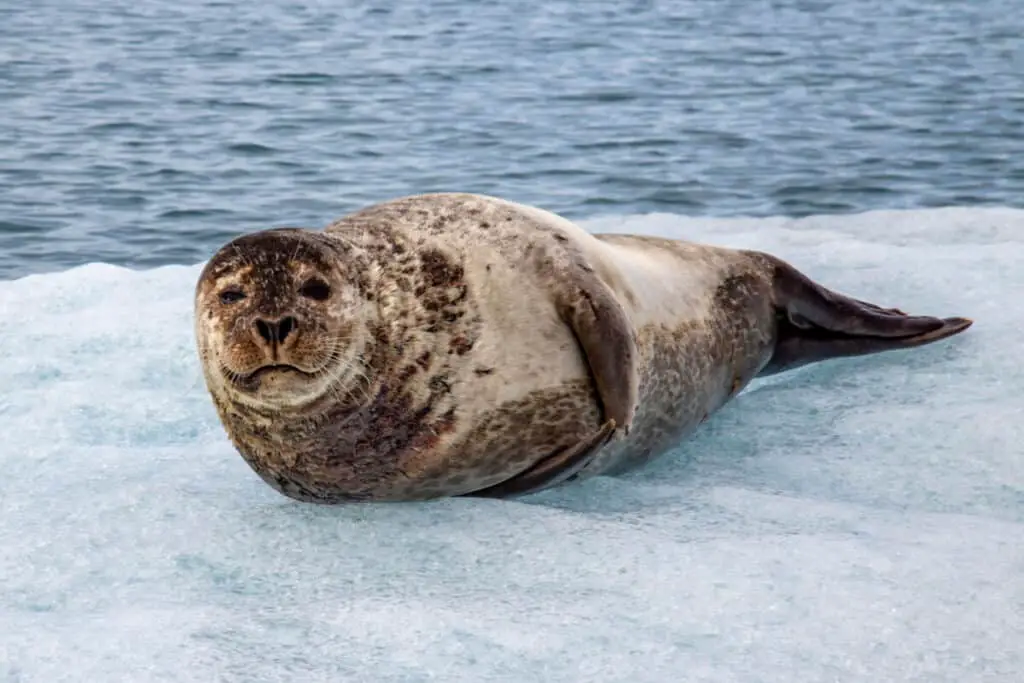Seal species are amongst the most diverse and varied marine mammal group, with 33 extant species across seven families.
Their body size varies greatly between species and even within a single species depending on geographical location.
Seals inhabit every ocean of the world, from polar regions to temperate waters.
Thus, understanding the physical dimensions of seals is essential for their conservation and study.
This article aims to provide an overview of seal sizes in relation to other aquatic mammals as well as providing insight into intraspecific variation in body size.
| Seal Species | Size Range | Weight Range |
|---|---|---|
| Elephant Seal | Males: 4-6 m (13-20 ft) in length | Males: 2,000-4,500 kg (4,400-9,900 lbs) |
| Females: 2.5-3.5 m (8-11.5 ft) in length | Females: 400-900 kg (880-1,980 lbs) | |
| Leopard Seal | 2.4-3.6 m (8-12 ft) in length | 200-600 kg (440-1,320 lbs) |
| Weddell Seal | 2.5-3.5 m (8-11.5 ft) in length | 400-600 kg (880-1,320 lbs) |
| Harbor Seal | 1.5-1.85 m (5-6 ft) in length | 55-170 kg (121-375 lbs) |
| Grey Seal | 1.8-2.3 m (6-7.5 ft) in length | Males: 170-310 kg (375-680 lbs) |
| Females: 130-190 kg (290-420 lbs) | ||
| Common Seal | 1.5-1.95 m (5-6.5 ft) in length | 70-170 kg (155-375 lbs) |
| Ringed Seal | 1.5-1.7 m (5-5.5 ft) in length | 45-95 kg (99-209 lbs) |
| Bearded Seal | 2.1-2.7 m (7-9 ft) in length | 200-430 kg (440-950 lbs) |
| Crabeater Seal | 2.3-2.6 m (7.5-8.5 ft) in length | 200-300 kg (440-660 lbs) |
| Hawaiian Monk Seal | 1.8-2.2 m (6-7 ft) in length | 200-270 kg (440-595 lbs) |
Please note that these size and weight ranges are approximate and can vary among individuals and populations within each seal species.

Species Variation
Seals are a diverse group of marine mammals with varied sizes, diets and habitat preferences.
An example is the world’s largest seal, the southern elephant seal (Mirounga leonina). They can reach up to 4.9 m in length and weigh around 5,000 kg – significantly larger than most other seals.
In terms of dietary differences, some species feed on fish while others prefer krill or squid. The ringed seal (Pusa hispida) for instance feeds mainly on small crustaceans such as shrimp and amphipods. Similarly, harbor seals (Phoca vitulina) tend to eat more fish than other species because they inhabit shallow coastal waters near fishing grounds.
When it comes to habitat preferences, many species enjoy spending time both ashore and in the water. For instance, harp seals (Pagophilus groenlandicus) use ice floes for breeding purposes during winter months but spend much of their year living in open ocean areas and searching for food at depths of up to 100 meters.
Overall, different types of seals have adapted to life at sea by developing specific features that allow them to thrive under various conditions – from extreme cold temperatures to deep-sea environments rich in prey items.
Consequently, these adaptations make them an integral part of our oceans’ biodiversity and an important component of healthy ecological systems worldwide.
Hawaiian Monk Seals’ Predators Revealed: Unraveling the Threats
Size Relative To Other Aquatic Mammals
Seals are a diverse group of aquatic mammals that vary in size according to species.
There are both large and small seal species, ranging from the 1.5 meter long Galapagos Fur Seal to the smaller Baikal Seal which measures only 70 centimeters on average.
Generally speaking, seals tend to be smaller than other marine mammal relatives such as whales and dolphins, but larger than sea otters and walruses.
Size is not the only difference between these animals; diet also varies significantly between them.
Seals primarily feed on fish, squid and crustaceans depending on the species, while some whales may rely on krill or plankton for sustenance.
Additionally, social behavior often differs between species: many seals form colonies where they can rest together and interact with one another, whereas most whale species live more solitary lives due to their enormous size.
These differences illustrate how unique each type of marine mammal is despite their shared environment—the ocean.
By understanding these distinctions we can better appreciate the complex relationship among all creatures living in our oceans today.
Geographic Variation
Seals show a remarkable degree of size variation. The smallest species, the Galapagos fur seal, typically weigh between 45 and 70 kilograms (100 – 150 lbs). On the other end of the spectrum is the southern elephant seal which can grow to over 4 tonnes (4,000 kg or 8800 lb).
Despite this large range in size among species, seals are generally much smaller than whales and dolphins.
The geographic distribution of different seal species also impacts their size. Generally speaking, seals inhabiting colder waters tend to be larger than those found in warmer climates. This is likely due to dietary habits; animals living in cold water often have access to more abundant food sources that allow them to reach larger sizes.
Additionally, certain mating rituals may favor bigger males as they compete for access to females. Consequently, it appears that environmental factors play an important role in determining how big seals become.
Intraspecific Variation
Intraspecific variation of seals varies greatly, depending on the species and location. Generally, seal species range in size from 1-2 meters long and weigh between 60 to 600 kgs. Diet habits also vary between different species; while some prefer to feed on fish, others may opt for crustaceans or shellfish. Some even consume squid and octopus when available.
Additionally, populations trends can be vastly different across regions due to local environmental conditions as well as human activities such a predation, hunting and fishing practices. As a result, conservation efforts must take into account these varying parameters when attempting to protect certain species of seals that are at risk of endangerment or extinction.
In order to ensure successful protection strategies are implemented over time, researchers need access to detailed data about population dynamics within specific areas and habitats.

Conservation Implications
Seals are a diverse group of semi-aquatic mammals renowned for their impressive adaptability and range. They vary greatly in size, from the minute dwarf seal to the gargantuan elephant seal – some individuals can be as small as 1 m (3 ft) while others may exceed 6 m (20 ft).
This immense variability in size has important consequences on conservation efforts aimed at preserving this remarkable species. The habitats used by seals span a wide range, from shallow coastal waters to deep subarctic seas; however, many populations have suffered significant declines due to human activity over recent decades:
- Overfishing has caused food shortages which have drastically reduced numbers across some areas.
- Pollution is known to disrupt breeding grounds and cause severe health issues among those exposed.
- Climate change has been linked with the collapse of certain habitat types that were formerly relied upon by these animals throughout their lifecycle.
- Sealing activities continue to pose a threat despite increasing public awareness and enforcement measures.
These trends highlight an urgent need for effective management strategies if we hope to protect current populations and prevent any further losses into the future. Conservation focused research must strive to understand population dynamics in order to implement appropriate mitigation techniques before it is too late.
Conclusion
The study of seals is essential for conservation efforts and to better understand their unique characteristics.
Seal species vary widely, with sizes ranging from the diminutive ringed seal to the massive elephant seal. Additionally, intraspecific variation exists within a species, due to differences in age, sex, and geographic location.
Seals are large compared to other aquatic mammals such as dolphins or whales; however they are still small-bodied when considered against terrestrial animals like polar bears or lions.
It is important to continue studying these marine creatures to gain further insight into their ecology and behavior patterns. With this knowledge we can ensure that critical habitats remain intact while helping endangered populations recover through appropriate management strategies.

